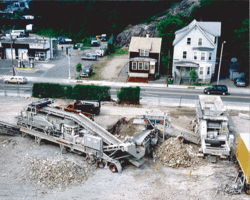Recycled aggregates
Contents
- 1 Aggregates are Required for Construction Projects
- 2 Recycled Aggregates Originate from Construction and Demolition Debris
- 3 Asphalt Recycling
- 4 Concrete Recycling
- 5 Recycling—Small Market Share, but Large Tonnage
- 6 Concrete Recycling Product
- 7 Economics of Recycling
- 8 The Future for Concrete Recycling
- 9 Summary
- 10 Further Reading
Aggregates are Required for Construction Projects
Aggregates are composed of rock fragments that may be used in their natural state or after mechanical processing such as crushing, washing, and sizing. Natural aggregates consist of both sand and gravel, and crushed stone. Recycled aggregates consist mainly of crushed concrete and crushed asphalt pavement.
Construction aggregates make up more than 80 percent of the total aggregates market, and are used mainly for road base, riprap, cement concrete, and asphalt. Aggregates provide bulk, strength, and wear resistance in these applications.
As American society evolved from rural-agrarian to urban-industrial, the demand for supporting infrastructure grew. Construction aggregates increased from 36 percent of all raw materials used in the United States in 1900 to 70 percent in 1958, a compound annual growth rate of 1.15 percent. From 1958 to 1998, Americans have maintained their use of construction aggregates at 70–73 percent of their total raw material demand.
Recycled Aggregates Originate from Construction and Demolition Debris

Much of the infrastructure that has been constructed since the 1950’s, particularly roads, has become, or is becoming obsolete and in need of replacement or repair. As Americans go about tearing up roads and tearing down buildings, they generate large quantities of demolition wastes, yielding over 200 million t (metric tons) of recycled aggregates annually.
Demolished infrastructure can be either disposed in landfills or recycled. The decision is usually made by the demolition contractor, taking into consideration regional economics, contract terms, and legal mandates.
Asphalt Recycling
Asphalt paving materials are recovered from demolished roads. These are valuable, both for the asphalt binder and for the aggregates. More than 100 million t of worn-out asphalt pavement are recovered annually. About 80 percent of the recovered material is currently recycled, and the remaining 20 percent reports to landfills. Two-thirds of the recycled material is used as aggregates for road base. The remaining one-third of recycled material is reused as aggregates for new asphalt hot mixes.
Concrete Recycling
Aging U.S. infrastructure, decreasing availability of landfill space, and environmental concerns work together to increase concrete recycling.
There are two approaches to recycling concrete. One alternative is to haul the concrete debris to a permanent recycling facility, usually close by to minimize transportation costs, for crushing and screening. The other approach is to do the crushing and screening at the demolition site where the aggregate is reused as soon as it is processed.
Recycling at the demolition site reduces heavy materials hauling, thereby reducing transportation costs, energy use, and wear and tear on roads and equipment.
An estimate prepared by William Turley, Construction Materials Recycling Association, Lisle, Illinois, states that about 100 million t of concrete is recycled annually into usable aggregates. Aggregates produced from recycled concrete supply roughly 5 percent of the total aggregates market (more than 2 billion t per year), the rest being supplied by aggregates from natural sources such as crushed stone, sand, and gravel. Preliminary data indicate that in 1998, 3,400 U.S. quarries produced about 1.5 billion t of crushed stone, of which about 1.2 billion t was used in construction applications. About 5,300 sand and gravel operations produced more than 1.0 billion t of construction aggregates in 1998.
Concrete Recycling Product

The bulk of the aggregates recycled from concrete—an estimated 68 percent—is used as road base. The remainder is used for new concrete mixes (6 percent), asphalt hot mixes (9 percent), high-value riprap (3 percent), low-value products like general fill (7 percent), and other (7 percent).
The low usage rate of recycled aggregates from concrete (15 percent) in high-value new concrete and asphalt hot mixes, compared to the higher usage rates in lower valued products, is related to quality issues, both real and perceived. State agencies have been slow to accept recycled aggregates from concrete for high-quality uses such as road surfacing. Specifications, based on considerable research and favorable in-service experience, have allowed its use mostly as road base material.
Some States are experimenting with the conversion of existing worn-out concrete roads to rubble-in-place. The old concrete surface is broken up and compacted, and asphalt pavement is placed over the enhanced base, composed of the original base and the new layer of compacted rubble.
Economics of Recycling
Concrete recycling has proven to be profitable, but its use has limitations. Transportation costs need to be kept low, which forces the market to be urban-oriented. The market for recycled aggregates may be restricted by user specifications and prejudices. Finally, the availability of feedstock into recycling plants is fixed by the amount of demolition taking place, which generally places the activity within older, larger cities.
Depending on the size of the recycling facility, entry into the aggregates recycling business requires a capital investment between $4.40 and $8.80 per metric ton of annual capacity.
Processing costs for the aggregates recycler range from $2.76 to $6.61 per metric ton, again depending on the size of the operation. The larger operations distribute costs over more units of output. The average production capacity for a fixed site recycling operation is about 150,000 t per year.
Prices (1999) for the various aggregate products made from recycled concrete range between $1 and $18 per metric ton and vary from region to region. The highest prices are in aggregate-poor areas of the southern United States.
Recyclers often have the opportunity to charge a fee for accepting concrete debris, especially along the Atlantic corridor where landfill space is running short and charges for depositing materials into landfills are high. In such cases, the added revenue can compensate for a lower market price for the recycled aggregate product. As natural aggregate producers dominate the market, they tend to set the terms that recyclers can obtain.
The Future for Concrete Recycling
The future for recycled aggregates will be driven by reduced landfill availability, greater product acceptance, continuing government recycling mandates, and the continuing decay of a large stock of existing infrastructure, as well as by the demands of a healthy economy.
Summary
The recycling of aggregates from recovered asphalt pavement and demolished concrete debris conserves resources and landfill space, while also generating healthy profits for recyclers. Recycling can take place either at a permanent facility or at the demolition site, using mobile equipment.
A sustainable recycling industry requires numerous factors, including sufficient concrete and asphalt decay and demolition to supply the recycler with raw materials, demand for new infrastructure, favorable transportation distances, product acceptance, and limited landfill space.
Further Reading
- Bolen, W.P., 1999. Sand and gravel (construction): U.S. Geological Survey Mineral Commodity Summaries 1999, p. 146–147.
- Deal, T.A., 1997. What it costs to recycle concrete: C&D Debris Recycling, September/October, p. 10–13. Kelly, T.D., 1998, The substitution of crushed cement concrete for construction aggregates: U.S. Geological Survey Circular 1177, 15 p.
- Tepordei, V.V., 1999. Stone (crushed): U.S. Geological Survey Mineral Commodity Summaries 1999, p. 162–163.
- Wilburn, D.R., and Goonan, T.G., 1998. Aggregates from natural and recycled sources: U.S. Geological Survey Circular 1176, 36 p.
| Disclaimer: This article is taken wholly from, or contains information that was originally published by, the U.S. Geological Survey. Topic editors and authors for the Encyclopedia of Earth may have edited its content or added new information. The use of information from the U.S. Geological Survey should not be construed as support for or endorsement by that organization for any new information added by EoE personnel, or for any editing of the original content. |